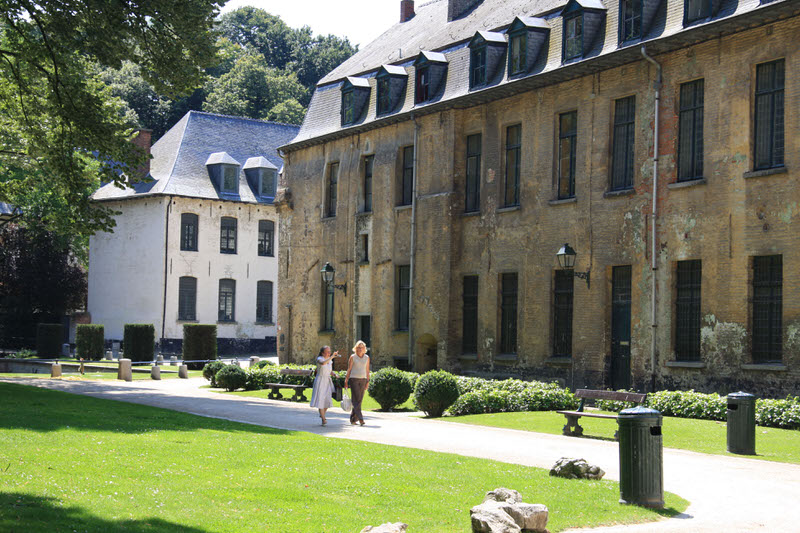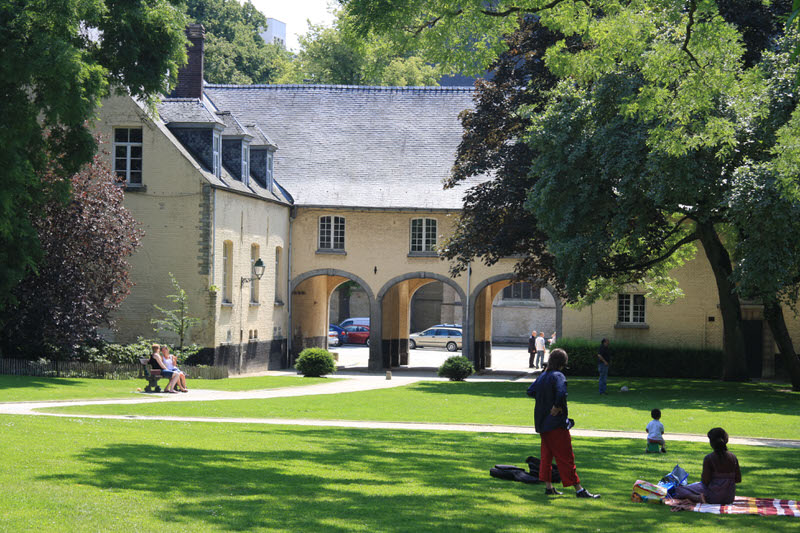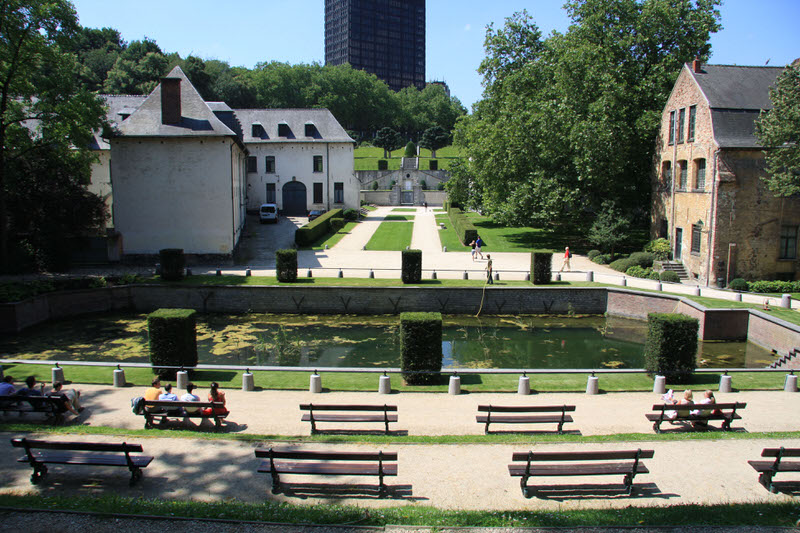The Abbaye of la Cambre’s attractive main courtyard, with its abbey lodgings flanked by corner pavilions and outbuildings arranged along a semicircular plan, forms a very harmonious 18th century ensemble, born of the desire of the abbesses to recreate the atmosphere of their family châteaux. The community usually consisted of about 100 women, many from families of high nobility in the duchy. Avenue de Mot overlooking the abbey provides the best view of the French-style terraced gardens. They were designed in about 1720 and restored in 1930. They are very restful, particularly on summer evenings when the illuminations are very attractive.
Location of the Abbaye de la Cambre:
The peaceful surroundings of the Abbaye of la Cambre

Entrance leading to the building housing the National Geographic institute

The church — The original 14C building was destroyed during the 1581 fire. When rebuilt at the end of the 16C under the auspices of Philip ll, it was incorporated into the surrounding buildings. The graceful Gothic facade is decorated with several sculptures. The Classical blue stone portal conceals a much more sober Gothic style porch which is partially concealed. The chevet and its beautiful buttresses are visible from the courtyard.
Abbey church entrance from the Cour d’honneur

Entering the Church

Closer look at the paintings the side

Opposite side of the church

Chapel

The entrance is in the northern transept which is, in fact, a false transept formed by two chapels. On the east wall is the shrine of St Boniface (rebuilt in the 17C). The single nave exemplifies Cistercian simplicity; it is roofed with wooden barrel vaulting (partially polychrome), lit by eight high tracery windows, and decorated with Stations of the Cross by Anto Carte (1886-1954). The chancel has stained-glass windows by the same artist but has lost its original vaulting which was replaced in the 17C. The most interesting features are a Mocking Christ by Aelbrecht Bouts (1452-1549) on the north wall of the nave; the Chapel of the Holy Sacrament, parallel to the nave, dedicated to St Philip Neri; the south transept which is also the Lady Chapel (see the consoles
carved with figures and symbolic animals) and which communicates with the chancel via a small opening.
School of decorative arts or École des Arts Décoratifs

Benches in from of the ducks pond or mare aux canards

Inside view of la cour d’honneur or Honor’s court in English

A bit of history of the Abbaye de la Cambre– In 1201, Duke Henry I and his wife Mathilda gave the Cistercian Sisters a small valley watered by the Maelbeek River, so charming that it was nicknamed Little Switzerland. Sister Gisela founded a monastery there. The future St Boniface, then Bishop of Lausanne, although originally from Brussels, went to live in the abbey in 1242 to flee Emperor Frederick II who had just been excommunicated by Pope Gregory IX. The abbey prospered, grew rich and reached the peak of its glory in the late 13C.But after the rise came the fall. The abbey suffered from the Wars of Religion in the 16C. In 1581, the nuns left the abbey, which was devastated by Spanish troops who set fire to the building to prevent the army of the States from seeking refuge there. Ever tenacious, the nuns returned in 1599, until Henri de Nassau caused the ruin of Brabant in 1622. A short time afterwards in 1635 the sisters evacuated the abbey to make way for French and Dutch troops. They returned just in time to see Louis XIV on his way to lay siege to the town of Maastricht in 1673. Unfortunately, in the words of Viscount Terlinden, “this dazzling apparition of war in lace collars soon disappeared, leaving in its wake only the sad reality of pillaging, extortion, ruin and death”.
Other building of the School of decorative arts or École des Arts Décoratifs

The jardins étagés

View from the top of the gardens

The Abbaye de la Cambre was suppressed in 1796 by the French Republic and now houses the services of the National Geographic Institute and several sections of the National School of Architecture and Decorative Arts, known as “La Cambre” its de La Cambre is a translation of the Latin camera (chamber) which lost its “h” under the influence of the Dutch Ter Kameren.
Opposite side of the École des Arts Décoratifs buildings

People often come to the ducks pond during the lunch break

Path that circling around Abbaye de la Cambre



3 comments
Merveilleux! je vivais mes 2 derniere années à Bruxelles et de la fenêtre je voyais l’Abbaye … curieuse au temps de Noel et me souvenant d’un marriage auquel je suis allée je me suis dit je vais voir votre website …. merci pour une bonne visite d’un bel endroit que je fréquentais quotidiennement de vue de notre appartement ave Louise … il y a maintenant 34 ans ….. Bonnes fetes!
Bon temps des Fêtes par chez vous aussi! Ou que cela soit 🙂
Fantástico. É impressionante como a natureza me faz bem!
Impossível imaginar um mundo cinza!